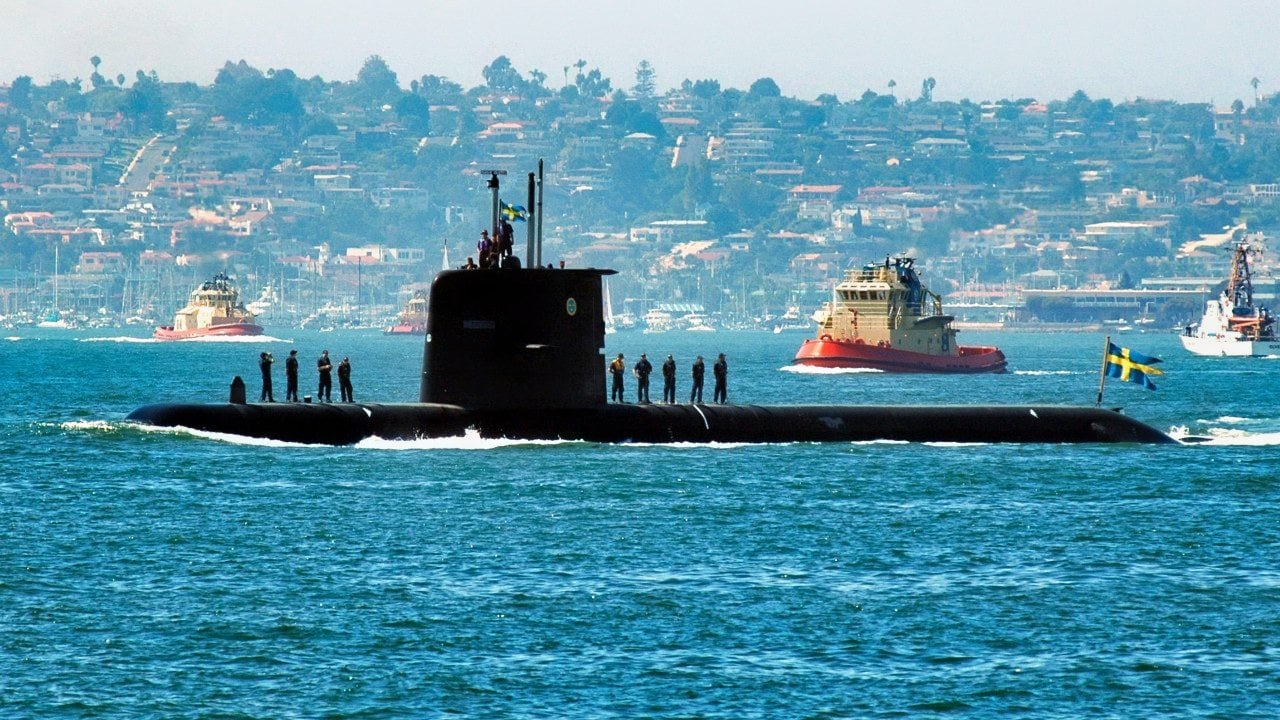What You Need to Know: Designed in the 1990s, Sweden’s Gotland-class submarine was groundbreaking due to its Air Independent Propulsion (AIP) technology, allowing it to stay submerged for weeks and operate with exceptional stealth.

-Equipped with features like an X-shaped rudder and sonar-resistant hull materials, the submarine can maneuver close to the seabed and evade detection. In 2005, a Gotland-class submarine famously “sank” the USS Ronald Reagan during naval exercises by evading detection and getting within firing range.
-This incident highlighted the vulnerability of expensive aircraft carriers to cheaper, stealthy submarines. The article argues that the U.S. Navy should reconsider its heavy investment in aircraft carriers and focus more on developing a fleet of manned and unmanned submarines, including AIP-powered models, to adapt to modern naval warfare paradigms.
How Sweden’s Gotland-Class Submarine “Sank” a U.S. Aircraft Carrier
Designed in the 1990s, Sweden’s Gotland-class submarine was a groundbreaking design that continues to prove itself to be an innovative system, only costing on average, $100 million per boat. It was the first submarine to operate Air Independent Propulsion (AIP) technology. In essence, the AIP gives these non-nuclear submarines greater capabilities as they can remain submerged for weeks when compared with older diesel-electric submarine designs.
These submarines, far cheaper than nuclear-powered submarines, are highly stealthy and can even easily get within range of American aircraft carriers without being detected by the variety of defenses those carriers come equipped with.
A Unique Boat
The Gotland-class submarine’s unique X-shaped rudder gives this submarine extraordinary maneuvering power, too. A Gotland-class sub can even operate close to the seabed, which only enhances the submarine’s stealth, as it helps to reduce the sub’s acoustic signature.
What’s more, the Swedes designed this boat with sonar-resistant hull materials. It can also deflect magnetic anomaly detectors and other sonar systems, thanks to its counter-detection systems onboard.
These capabilities have given this tiny submarine the ability to pack quite a wallop, especially when squaring off against more advanced systems, such as the aforementioned American aircraft carriers. The Gotland-class submarine proved it could sink U.S. carriers during an infamous naval exercise in 2005.

Back then, the USS Ronald Reagan was engaged in a wargame against a team that included allied submarines, such as the Gotland-class. The Gotland-class sub evaded all detection because of its unique stealth features and AIP technology, got within firing range of the Ronald Reagan, and sank her.
Further, the incident was not just an anomaly for the Gotland-class. Like a scientist proving their theory to be true, the Swedish Navy repeated the event multiple times. Each time, the submarine evaded detection and got within firing range, and, if this were a real wartime scenario, would have fired enough torpedoes to sink the carrier.
For Sweden, it was a moment to be proud of. They do not have a large navy. And their budget is a fraction of what other great powers, notably the United States and Russia, spend on their navies. But the Swedes proved this system that they had built could stymie even the seemingly awesome power of the mighty U.S. Navy.
This was a wake-up call, or it should have been, for the U.S. Navy to not put all its strategic eggs in the aircraft carrier basket. We are told that this experience with the Gotland-class submarine was instructive for the U.S. Navy, which dutifully went about ensuring that countermeasures to AIP-powered submarines were instituted on their carriers.
A Dangerous Precedent
Yet, the Swedish capability demonstrated in their Gotland-class submarine that the new age of warfare would be asymmetrical and cheap, for the challenging power, when faced with the established power.
A simple, non-nuclear submarine can, and will, potentially sink a far more expensive aircraft carrier, the loss of which could fundamentally upend the U.S. Navy’s entire strategic posture in a given region.
Indeed, there is a paradigm shift underway in modern naval warfare and the Gotland-class submarine is its herald. What’s more, the experience the U.S. Navy had in its failed attempt to defend its most important platforms from the cheaper Gotland-class submarine should prove that the way the U.S. Navy has been planning to wage war in a near-peer conflict is all wrong.

Rather than blowing thirteen billion USD that the U.S. military cannot afford to part with on vanity projects, like the Ford-class aircraft carrier, the Pentagon should be judiciously spending less money on building a fleet of both manned, including non-nuclear, AIP-powered submarines, and unmanned submersibles.
Sweden exports versions of the Gotland-class submarine to Singapore, Denmark, and Australia, according to the Nuclear Threat Initiative. Imagine if American rivals decided to start purchasing these systems, or simply copy them. No U.S. carrier force would be safe.
Author Experience and Expertise: Brandon J. Weichert
Brandon J. Weichert, a National Interest national security analyst, is a former Congressional staffer and geopolitical analyst who is a contributor at The Washington Times, the Asia Times, and The-Pipeline. He is the author of Winning Space: How America Remains a Superpower, Biohacked: China’s Race to Control Life, and The Shadow War: Iran’s Quest for Supremacy. His next book, A Disaster of Our Own Making: How the West Lost Ukraine, is due October 22 from Encounter Books. Weichert can be followed via Twitter @WeTheBrandon.
All images are Creative Commons or Shutterstock.
From the Vault
Russia Freaked Out: Why the U.S. Navy ‘Unretired’ the Iowa-Class Battleships
Battleship vs. Battlecruiser: Iowa-Class vs. Russia’s Kirov-Class (Who Wins?)
